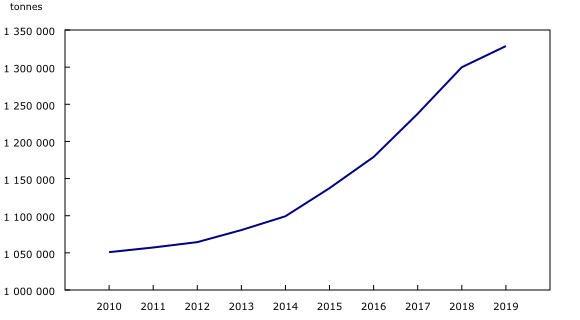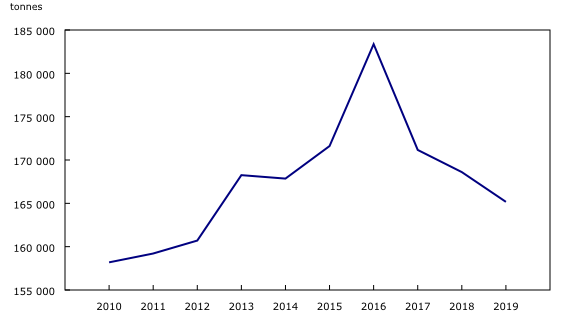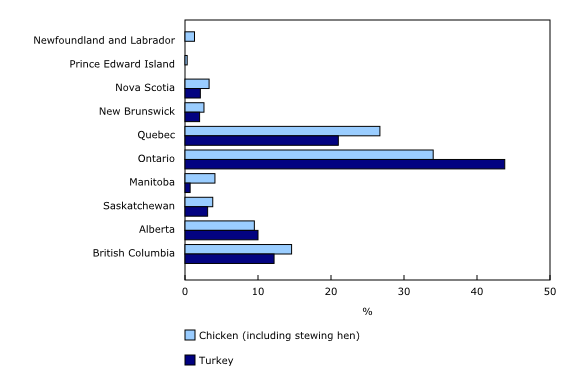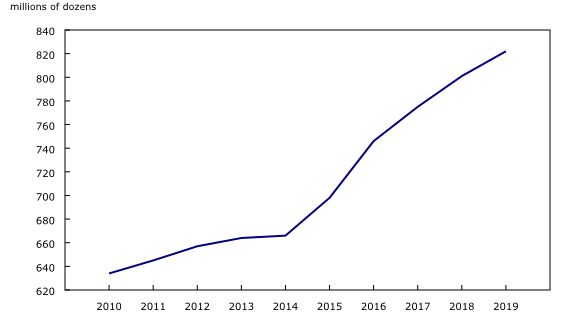Poultry and egg statistics, May 2020 and annual 2019
Archived Content
Information identified as archived is provided for reference, research or recordkeeping purposes. It is not subject to the Government of Canada Web Standards and has not been altered or updated since it was archived. Please "contact us" to request a format other than those available.
Released: 2020-05-27
Monthly poultry and egg data were collected during the early stages of the COVID-19 pandemic. The impact of COVID-19 on poultry and eggs is expected to become clearer in subsequent releases.
Data on stocks of frozen eggs and poultry meats, as well as edible dried egg products, are available for May 2020. Data on the placements of hatchery chicks and turkey poults are available for April 2020. Data on egg production are available for March 2020. Annual data on poultry and egg production are available for 2019.
Egg production rose 5.3% to 71.0 million dozen eggs from March 2019 to March 2020. In April 2020, placements of hatchery chicks on farms decreased 0.5% compared with April 2019, to 68.9 million birds. Stocks of frozen poultry meat in cold storage increased 3.9% to 90 958 tonnes from May 1, 2019, to May 1, 2020.
Annual data
Poultry farmers ramped up production for the 10th consecutive year in 2019, as chicken and eggs remained a popular food choice for many Canadians. Ontario and Quebec accounted for over half the chicken produced in Canada in 2019, and almost two-thirds of the turkey.
Canadian poultry (including chicken, turkey and stewing hen) farmers produced a record 1 493.5 million kilograms in 2019, up 1.7% compared with 2018. This marked the 10th consecutive annual increase in the total weight of poultry birds produced in Canada, the result of increased chicken and stewing hen production.
Sales of poultry meat (including chicken, turkey and stewing hen) increased 3.8% to $3.2 billion in 2019.
Net egg production rose 2.7% to 822.4 million dozen eggs from 2018 to 2019—the 15th consecutive annual increase.
Chicken accounts for over four-fifths of poultry production
In 2019, the weight of chicken produced increased for the 10th consecutive year, reaching the highest value on record. Chicken, including stewing hen, accounted for 88.9%, or 1 328.4 million kilograms, of total poultry produced—a 2.2% rise in production from 2018.
According to the "Food availability" release in The Daily on May 30, 2019, per capita availability of chicken and stewing hen rose 13.7% from 2010 to 2018 (see note to readers).
Turkey accounts for over one-tenth of poultry production
Turkey production declined 2.0% to 165.2 million kilograms from 2018 to 2019. Turkey available for consumption decreased 1.4% from 2010 to 2018.
By way of comparison, per person availability of pork (-1.7%) and beef (-10.0%) was also down from 2010 to 2018.
Since 2010, chicken prices have risen at a much slower pace than beef and pork prices
From January 2010 to January 2019, prices for stewing beef (+63.4%) rose the most, followed by prices for pork (+34.2%) and chicken (+18.4%). The smaller price increase for chicken compared with other popular meats may have led to greater consumer demand, which spurred chicken production and availability for consumption.
Health concerns may have also played a role in Canadians opting for chicken over other meats. Canada's Food Guide recommends lean meats instead of fatty meats as a source of protein and suggests limiting trans and saturated fats. Poultry meat does not contain trans fat and is lower in saturated fat than red meat. Therefore, some consumers may choose poultry over red meat for health reasons.
Among the provinces, Ontario produces and sells the most poultry
Ontario accounted for just over one-third (34.0%), or 451.3 million kilograms, of the chicken (including stewing hen) produced in Canada in 2019. Quebec accounted for over one-quarter (26.7%), or 354.2 million kilograms. Ontario and Quebec were also responsible for most of the turkey produced in Canada in 2019: Ontario produced 43.8%, or 72.4 million kilograms, and Quebec produced 21.0%, or 34.7 million kilograms.
In 2019, Ontario's sales of poultry meat (including chicken, turkey and stewing hen) represented 34.3%, or $1.1 billion, of Canada's poultry sales. Meanwhile, Quebec's sales accounted for 25.5%, or $0.8 billion.
In 2019, Newfoundland and Labrador farmers received the most for their chicken (including stewing hen), $2.35 per kilogram on average, while farmers in Ontario received the least ($2.07 per kilogram).
Turkey prices were highest for farmers in Saskatchewan in 2019 ($2.39 per kilogram) and lowest in New Brunswick ($2.26 per kilogram).
Lower provincial levies result in a larger cut for egg producers
The annual per capita availability of eggs for consumption in Canada increased 29.2% to 15.04 kilograms from 2010 to 2018.
Egg prices rose 18.0% to $3.08 per dozen from January 2010 to January 2019. This meant eggs were less expensive than stewing beef ($15.26 per kilogram), pork chops ($12.33 per kilogram) and chicken ($7.52 per kilogram).
While the net production of eggs rose 2.7% from 2018 to 2019, the total value of eggs produced was up 5.7%, to $1,569.5 million. This led to an increase in the average value of eggs produced, from $1.86 per dozen in 2018 to $1.91 per dozen in 2019. The average value of eggs is the total value of egg production over the net production of eggs.
The higher average value of eggs matches the increase in the monthly farm price of eggs. In 2018, the average price for eggs paid to farmers ranged from 153.4 cents per dozen to 162.9 cents per dozen. In 2019, the price ranged from 153.5 cents per dozen to 163.3 cents per dozen. One reason for this increase may be that farmers paid lower levies to their provincial boards, which increased the amount of revenue they were able to keep.
Producers in British Columbia receive the most, on average, for eggs
The average price of eggs paid to producers rose in every province from 2018 to 2019. Producers in British Columbia received the most for eggs—$2.19 per dozen, on average—up 3.7% from 2018. Meanwhile, producers in Prince Edward Island received the least, at $1.62 per dozen, up 5.6%.
Note to readers
Poultry and egg statistics are available for Canada and the provinces.
Annual data on poultry and egg production are available for 2019.
Data on frozen eggs and poultry meats include chicken, turkey and duck stocks, as well as stocks of egg whites, egg yolks and dried eggs. Data on egg production include egg production, disposition, home consumption and prices.
Food availability data come from the Daily release on food availability and the "Food available in Canada" table (32-10-0054). These data are obtained by dividing the domestic disappearance of a commodity by the Canadian population as of July 1 of the reference year to obtain the amount of a given food available per person. The domestic disappearance is calculated by removing exports, food going to further manufacturing, waste, and ending stocks from the total supply of a commodity (including beginning stocks, imports and production).
Price data are taken from the monthly Daily release on the Consumer Price Index, specifically table 18-10-0002, "Monthly average retail prices for food and other selected products." These data come from the monthly Consumer Price Index Survey.
Products
The Agriculture and food statistics portal, accessible from the Subjects tab on the Statistics Canada website, provides users with a single point of access to a variety of information related to agriculture and food.
Revisions
Weekly and monthly poultry and egg data have been revised back to January 2017 as a result of revisions to administrative data and survey data. Details are available upon request.
Contact information
For more information, or to enquire about the concepts, methods or data quality of this release, contact us (toll-free 1-800-263-1136; 514-283-8300; STATCAN.infostats-infostats.STATCAN@canada.ca) or Media Relations (613-951-4636; STATCAN.mediahotline-ligneinfomedias.STATCAN@canada.ca).
- Date modified:





